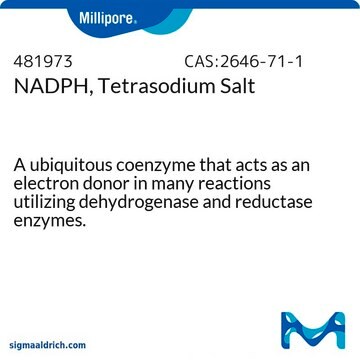D6566
Dihydrofolate Reductase human
≥80% (SDS-PAGE), recombinant, expressed in E. coli, ≥1 units/mg protein
Sinónimos:
DHFR, Tetrahydrofolate NADP+ oxidoreductase
About This Item
Productos recomendados
recombinante
expressed in E. coli
Nivel de calidad
Análisis
≥80% (SDS-PAGE)
formulario
solution
actividad específica
≥1 units/mg protein
mol peso
25 kDa
concentración
0.02-0.06 mg/mL
Nº de acceso UniProt
Condiciones de envío
wet ice
temp. de almacenamiento
−20°C
Información sobre el gen
human ... DHFR(1719)
Descripción general
Aplicación
- to investigate the stable expression of green fluorescent protein and the targeted disruption of thioredoxin peroxidase-1 gene in Babesia bovis
- to study the structural analysis of human dihydrofolate reductase as a binary complex
- to study its in vitro kinetic assay for the enzyme inhibition study
Acciones bioquímicas o fisiológicas
NADPH 0.16 mM
7,8-dihydrofolate 0.03 mM
8-methylpterin 0.13 mM
Ki7
Folate 2.6x10-5 mM
Methotrexate 6.1-9x10-9
Definición de unidad
Forma física
sustrato
Código de clase de almacenamiento
12 - Non Combustible Liquids
Clase de riesgo para el agua (WGK)
WGK 3
Punto de inflamabilidad (°F)
Not applicable
Punto de inflamabilidad (°C)
Not applicable
Equipo de protección personal
Eyeshields, Gloves, multi-purpose combination respirator cartridge (US)
Certificados de análisis (COA)
Busque Certificados de análisis (COA) introduciendo el número de lote del producto. Los números de lote se encuentran en la etiqueta del producto después de las palabras «Lot» o «Batch»
¿Ya tiene este producto?
Encuentre la documentación para los productos que ha comprado recientemente en la Biblioteca de documentos.
Los clientes también vieron
Artículos
Biofiles reviews innovative technologies for cancer research, reflecting the complexity of the disease.
Cancer research innovations address the complexity of the disease, providing advanced technologies for varied applications.
Nuestro equipo de científicos tiene experiencia en todas las áreas de investigación: Ciencias de la vida, Ciencia de los materiales, Síntesis química, Cromatografía, Analítica y muchas otras.
Póngase en contacto con el Servicio técnico












